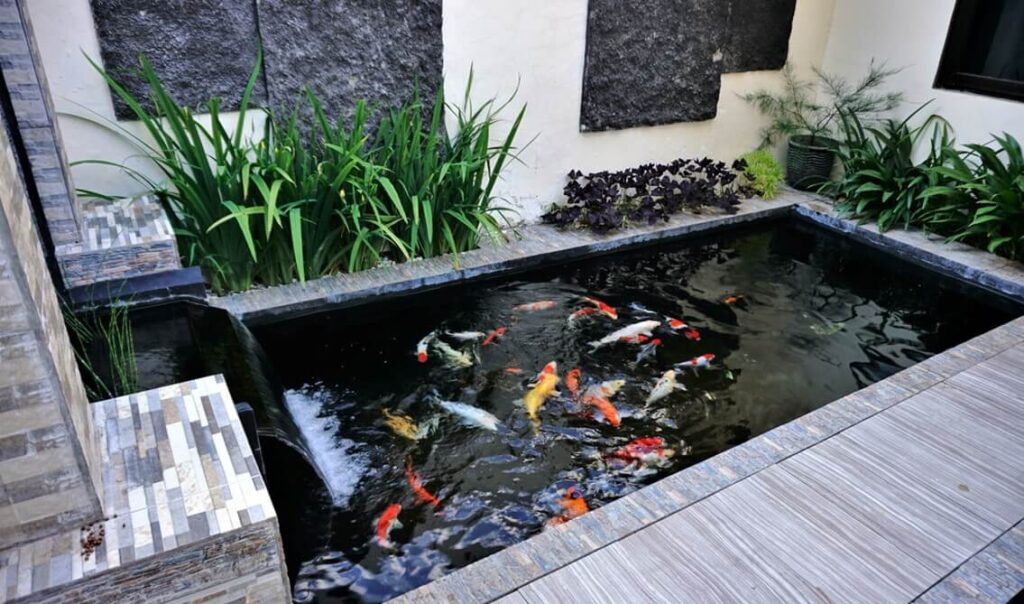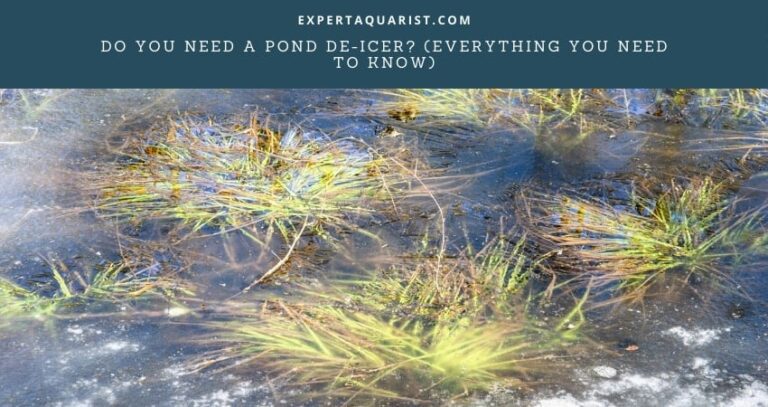A dirty koi pond is not only an eyesore but can also cause the fish to get sick or die. While the koi pond is designed with some components such as a skimmer and filter to ensure it is self-cleaning, it is recommended to deep clean it at least once or twice per year.
Over time, debris and dirt collect in the pond altering the water quality. The best time to clean your koi pond is during spring. At this time, the water in the pond is just starting to thaw, and the fish are becoming active. There are minimal algae and bacteria in the pond, making cleaning easier.

However, you can clean the pond more regularly if it tends to get dirty fast. Fall is also a great time to clean your koi pond. During fall, the pond may be filled with leaves and plant debris.
There are different ways to clean a koi pond. The main difference is whether you drain it completely and remove the fish. Deep cleaning necessitates draining the water to clean the bottom of the pond.
Alternatively, you can use a pond vacuum to clean the bottom of the pond without draining the water and removing the fish. Whichever option you prefer, take measures to avoid disturbing or killing the fish.
This article will discuss the various methods of cleaning koi ponds and provide the following steps.
Regular Koi Pond Cleaning
Although deep cleaning should be done a few times a year, you should routinely clean the pond 2-3 times per week or daily. These routine pond maintenance measures reduce dirt and skunk build-up and make deep cleaning less frequent and easier.
Below are tips for routinely cleaning your koi pond:
- Use a scoop to clean out debris and dirt at the top of the water 2-3 times per week or daily as the need arises.
- Skim the pond several times a week to remove gunk and debris at the bottom of the pond.
- Replace 10-15% of the water in the pond each week to maintain quality. It is easy to change the water. Simply scoop out 10-15% of the water from the pond and then refill it with a similar amount of fresh water. If using tap water, make sure to dechlorinate it before refilling the pond.
- Empty and clean the pump baskets and skimmers 2-3 times per week as they tend to collect muck. As a result, the filter’s ability to retain water quality is compromised.
- Add supplemental bacteria in the water at least once per week. The bacteria help to maintain a healthy aquatic ecosystem in the pond. Check the product packaging for instructions on how much beneficial bacteria to add to your pond, depending on its size. Most require to be mixed in a glass of warm water. The warm water dissolves it quickly and enables even distribution in the pond.
How to Clean a Koi Pond Without Draining
What You Need
- Pond net
- Pond vacuum cleaner
- Pond supplemental bacteria
- UV clarifier
- Filter cartridge
Steps
1. Clean the floating debris on the surface of the water

Use a wide pond net with a long handle and fine mesh to catch even fine debris. If left on the surface of the water for too long, the floating debris sink to the bottom of the pond liner. The pond net collects sticks, twigs, leaves, insects, etc.
You can use an automatic skimmer instead of a basic pond net for faster cleaning. It is a great option for regular cleaning if you have many fish in your koi pond and you want to keep the surface of the water clear at all times.
If you have a large pond, go for a box skimmer with a high capacity. Floating and submerged skimmers work well for smaller koi fish ponds. Although costly, skimmers make the cleaning process much easier and remove even finer debris that you may not see with your eyes.
2. Clean the bottom of the pond with a pond vacuum cleaner
Pond vacuums enable you to clean the bottom of the pond without having to drain the water. It is effective at combating sludge and takes a short time to clean it. Note that you do not have to remove all the debris and dirt at the bottom of the pond. A little bit of it helps to maintain a healthy ecosystem.
If your pond is deep, attach a long handle to the vacuum head to enable you to reach the deepest parts of the pond. You will also require a vacuum with powerful suction for cleaning deep ponds. Some pond vacuums tend to lose suction as they go deeper.
3. Add beneficial bacteria
As with routine cleaning, add beneficial bacteria to the pond after cleaning it. The bacteria break down residual organic sludge at the bottom of the pond. It also boosts the nitrogen cycle, providing aquatic life with essential nutrients. Excess sludge at the bottom of the tank leads to high levels of ammonia in the water, which can be toxic to the fish.
4. Clean algae
Over time, algae die and become sludge. Although koi fish eat algae, they do not consume much of it. Therefore, you will need to incorporate other ways of managing algae growth in the tank. For example, you can include other algae-eating fish compatible with koi fish in the pond.
If there are free-swimming algae in the pond, use a UV clarifier to clean it. A UV clarifier filters the algae and breaks it down at a cellular level. A pond vacuum also does a good job of getting rid of algae.
5. Clean the filters
Finally, do not forget to clean the filters. Wash the filters to get rid of accumulated debris. If the mechanical filtration media is worn out, replace it. If the filter is clogged or damaged, it reduces its cleaning efficiency.

How to Drain and Clean a Koi Pond
What You Need
- Pond net
- Pond vacuum cleaner
- Pond supplemental bacteria
- UV clarifier
- Filter cartridge
- Holding container
Steps
1. Use a pond net or skimmer to clean floating debris
2. Drain the pond water
Gently drain 80% of the pond water taking care not to disrupt the fish. Use the pond pump to drain the water in an area with good drainage. Leave about 1-foot high of the water.
Transfer the fish to a holding container. Fill the container with 1-foot high of water from the pond. Use a skimmer net to capture the fish and put them in the container. Cover the container with a net or a breathable material to prevent the fish from jumping out. Put the container away in a shaded area.
3. Drain the remaining pond water
After removing the fish, open the pump and drain all the remaining water.
4. Clean all accessories
Start by rinsing the pump to remove any debris. Then rinse the pond filter and the filter media. Do not use tap water to clean the filter; use dechlorinated water. Tap water cleans out the good bacteria on the accessories.
If the pond has water features, disassemble them and wash them. Use a soft brush to gently scrub and clean any stuck dirt. Do not use detergents or chemicals to clean the pond or its accessories.
5. Leave the pond and accessories to dry
Allow at least one hour for the pond and accessories to dry. The sun dries any residual algae and debris on the pond, making it easy to clean.
6. Clean the pond
Use a high-pressure hose to blast debris and sludge from the pond bottom. Then come in with a pond vacuum to clean any dirt and sludge not washed off by the hose. Leave velvet algae intact, as it benefits the pond’s aquatic life.
7. Put the accessories back into the pond
Start by reinstalling the pump and pond filter. If the filter media is worn out, replace it. Reinstall other accessories and water features.
8. Refill the pond
Use a garden hose to refill the pond with tap water. Add a dechlorinator to the water to remove chlorine. Turn on the pond pump and let it circulate the water for 5-10 minutes. Add beneficial bacteria into the water.
9. Transfer the fish back to the pond
Add some of the water into the holding tank to the pond and replace it with the fresh water from the pond. Repeat this 2-3 more times, each time allowing the fish to acclimate the fish to the new pond water. This transfer method avoids shocking the fish.
Finally, use the skimmer net to put the fish back into the pond. Observe them over the next 12-48 hours to ensure they are well-acclimated to the new water.
Conclusion
As discussed above, when pond cleaning, you can either drain the pond water completely and remove the fish or clean the pond with the fish still in there. Removing the fish from the pond works best for smaller ponds and fewer fish.
If you have a large pond, it is best to clean the pond without draining all the water. You could also hire a professional koi pond cleaning service.






